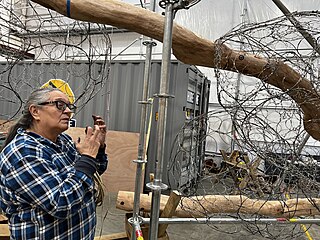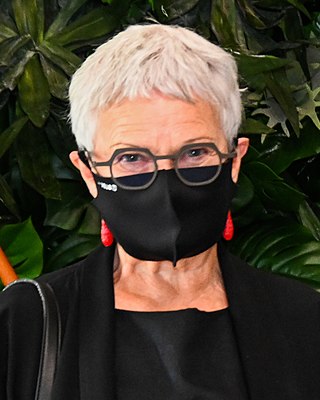Related Research Articles

The Museum of New Zealand Te Papa Tongarewa is New Zealand's national museum and is located in Wellington. Usually known as Te Papa, it opened in 1998 after the merging of the National Museum of New Zealand and the National Art Gallery. An average of more than 1.1 million people visit every year, making it the 58th-most-visited art gallery in the world in 2023. Te Papa operates under a bicultural philosophy, and emphasises the living stories behind its cultural treasures.

Shona Rapira Davies is a New Zealand sculptor and painter of Ngātiwai ki Aotea tribal descent currently residing in Wellington, New Zealand.

Michael Duncan Smither is a New Zealand painter and composer.

Shigeyuki "Yuki" Kihara is an interdisciplinary artist of Japanese and Samoan descent. In 2008, her work was the subject of a solo exhibition at the Metropolitan Museum of Art in New York; it was the first time a New Zealander and the first time a Pacific Islander had a solo show at the institution. Titled Shigeyuki Kihara: Living Photographs, the exhibition opened from 7 October 2008 to 1 February 2009. Kihara's self-portrait photographs in the exhibitions included nudes in poses that portrayed colonial images of Polynesian people as sexual objects. Her exhibition was followed by an acquisition of Kihara's work for the museum's collection.
James Patrick Hanly, generally known as Pat Hanly, was a prolific New Zealand painter. One of his works is a large mural Rainbow Pieces (1971) at Christchurch Town Hall.

William Franklin Culbert was a New Zealand artist, notable for his use of light in painting, photography, sculpture and installation work, as well as his use of found and recycled materials.

Lisa Walker is a contemporary New Zealand jeweller.

Maureen Robin Lander is a New Zealand weaver, multimedia installation artist and academic. Lander is of Ngāpuhi and Pākehā descent and is a well-respected and significant artist who since 1986 has exhibited, photographed, written and taught Māori art. She continues to produce and exhibit work as well as attend residencies and symposia both nationally and internationally.
Areta Rachael Wilkinson is a New Zealand jeweller.
Saskia Leek is a New Zealand painter.

Dame Robin Adair White is a New Zealand painter and printmaker, recognised as a key figure in the regionalist movement of 20th-century New Zealand art.

Judith Ann Darragh is a New Zealand artist who uses found objects to create sculptural assemblages. She has also worked in paint and film. Darragh is represented in a number of public collections in New Zealand. In 2004, The Museum of New Zealand Te Papa Tongarewa held a major retrospective of her work titled Judy Darragh: So... You Made It?

Jenny D. A. Campbell (1895–1970) was a Scottish artist. Works by Campbell are held at the Auckland Art Gallery Toi o Tāmaki and the Museum of New Zealand Te Papa Tongarewa. Her prints are featured in Margaret Dobson's book Block-Cutting and Print-Making by Hand (1928).

Suzanne Goldberg (1940–1999) was a New Zealand painter, born in Auckland, New Zealand.
Marion Elizabeth Tylee was a New Zealand artist.
Carole Marie Shepheard is a New Zealand artist. She specialises in printmaking and her work is held in national and international collections including the Museum of New Zealand Te Papa Tongarewa and the Auckland Art Gallery Toi o Tāmaki.
Susan Skerman is a New Zealand artist.
Elizabeth Wallwork was a New Zealand artist.
Denise Copland is a New Zealand artist, born in Timaru. Her works are held in the permanent collections of Auckland Art Gallery Toi o Tāmaki and Museum of New Zealand Te Papa Tongarewa.

Mary Louise Kisler is a New Zealand curator, author, art historian and Radio New Zealand art commentator. She is best known for her publications which include Angels & Aristocrats: Early European Art in New Zealand Public Galleries (2010) and Finding Frances Hodgkins (2019).
References
- ↑ Kirker, Anne. "The rub of place and connections: Stanley Palmer's prints 1960-1980" (PDF). Retrieved 16 May 2022.
- ↑ "The collections of a renowned artist". NZ Herald. Retrieved 16 May 2022.
- ↑ New Zealand Fine Prints Ltd, Stanley Palmer , retrieved 1 November 2008
- ↑ Feeney, Warren (1 April 2022). "10 exhibitions to look out for in April". Stuff. Retrieved 16 May 2022.
- ↑ "Get Cultured At Auckland's Best Art Galleries". www.theurbanlist.com. Retrieved 16 May 2022.
- ↑ MCPHEE, ELENA (4 May 2016). "Millennium Public Art Gallery in Marlborough will host floor talk by artist Stanley Palmer". Stuff. Retrieved 16 May 2022.
- ↑ Pardoe, Sharron (9 December 2020). "Print exhibitions few and far between in the city's galleries". Stuff. Retrieved 16 May 2022.
- ↑ Feeney, Warren (28 December 2018). "Ten 'must see' exhibitions in Christchurch in January". Stuff. Retrieved 16 May 2022.
- ↑ Black, Eleanor (10 April 2020). "Bring it Home: art dealer Melanie Roger". Stuff. Retrieved 16 May 2022.
- ↑ Amery, Mark (12 October 2019). "Deal with it: The Great Auckland Art Dealer Questionnaire". The Spinoff. Retrieved 16 May 2022.
- ↑ "10 must-see exhibitions to look out for in July". Stuff. 28 June 2019. Retrieved 16 May 2022.
- ↑ Reporter, Chloe Ranford Local Democracy (1 March 2022). "Pictures tell story of multi-million dollar council art collections". Stuff. Retrieved 16 May 2022.
- ↑ "Collections Online - Museum of New Zealand Te Papa Tongarewa". collections.tepapa.govt.nz. Retrieved 16 May 2022.
- ↑ "Stanley Palmer". Auckland Art Gallery. Retrieved 16 May 2022.
- ↑ "Beside The Road - Karamea". christchurchartgallery.org.nz. Retrieved 16 May 2022.
- ↑ "Queen's Birthday honours list 2001". Department of the Prime Minister and Cabinet. 4 June 2001. Retrieved 2 July 2020.
- ↑ "East". Potton & Burton. Retrieved 16 May 2022.
- ↑ "Stanley Palmer: To the Harbour - Te Uru". www.teuru.org.nz. Retrieved 16 May 2022.
- ↑ MCPHEE, ELENA (4 May 2016). "Millennium Public Art Gallery in Marlborough will host floor talk by artist Stanley Palmer". Stuff. Retrieved 14 May 2023.
- ↑ Pasley, Michael Wright, Brad Flahive and James (20 August 2017). "Artworks used to funnel secret donors' contributions to the Labour Party". Stuff. Retrieved 16 May 2022.
{{cite web}}: CS1 maint: multiple names: authors list (link)